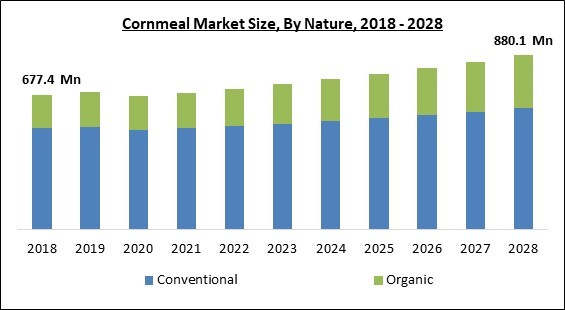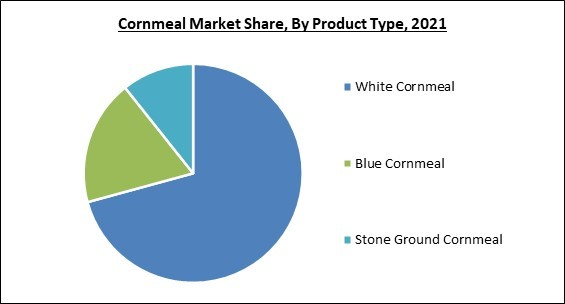Cornmeal is a meal made from grinding dried maize or corn. It is the common basic meal that can be processed to coarse, medium, or fine textures - but not quite as fine as wheat flour. After rice and wheat, corn is the third most common food in the world. For millions of people, corn is a staple food. It is also the most significant plant source of food which is nutritionally dense and is much needed for those living in developing nations, particularly those in Africa, Asia, and Latin America.
Additionally, cornmeal is a rich source of iron, phosphorus, and fiber. Magnesium and thiamine are both relatively abundant in cornmeal as well. Likewise, it is a good source of selenium. It is also a great source of vitamin B6 and folic acid. Major nutrients included in cornmeal include carbohydrates, iron, and phosphorous, which support healthy blood flow, nerve function, increased bone density, and enhanced healing.
Since cornmeal is gluten-free, it can be combined with flour to give baked goods a characteristic crunchy texture. As a grain and as a component of a balanced diet, cornmeal can provide a number of health advantages. Cornmeal is also available in a great many varieties, thus making it a versatile food as well. The difference between whole-grain and degerminated cornmeal is crucial.
Corn kernels are composed of three sections, similar to wheat and other grains: the fibrous hull; the starchy endosperm; and the oil- and vitamin-rich germ or heart. Since whole-grain cornmeal incorporates all three, it has twice the nutritional value of regular cornmeal and a deeper, richer flavor. However, wholegrain cornmeal soon goes rancid if not kept in the freezer or refrigerator because the germ is so heavy in oil.
COVID-19 Impact Analysis
The shutdown created a shortage of labor, which posed problems for functioning factories. It caused the production of cornmeal to be delayed. The demand for cornmeal and cornmeal-based products also lowered during the pandemic. The commercialization of cornmeal gained attention and glorified the negative connotations attached to excessive consumption of cornmeal. This included its high sugar content and lack of niacin. However, as the pandemic subsided, the restrictions have been lifted. So far, markets have gained momentum which has sparked a rise in the cornmeal market.Market Growth Factors
Presence Of Various Vitamins And Minerals is expected to Create Opportunities
Many vitamins and minerals are present in cornmeal and that makes it a healthy choice. According to the USDA's nutritional analysis, one serving of cornmeal has 142 mg of potassium, 147 mg of phosphorus, and 77.5 mg of magnesium, each of which amounts to 4%, 12%, and 20% of daily value respectively. It also contains 4.2 milligrams of iron in a single cup measure. This is more than half of the 8 milligrams per day recommended for men and 23% of the 18 milligrams per day for women.Increasing Cornmeal-Based Products’ Demand As A Substitute For Regular Snacks
A sharp rise in companies proposing the balanced breakfast approach made up of ready-to-eat foods is being favored by consumers. Additionally, a shift toward healthier diets to lower cholesterol and manage blood sugar levels has also been observed. These has led to an increase in cornmeal demand. Moreover, people are utilizing cornmeal as a food coating in their homes and restaurants. The growing number of fast food joints are also incorporating cornmeal in their menus.Market Restraining Factors
Unsuitable For Diabetes Patients Because Of Its High Carbohydrate And Sugar Content
The high carbohydrate content of cornmeal restricts product consumption. Cornmeal contains a lot of sugar and is challenging to digest. People with diabetes are advised to avoid eating cornmeal since it raises blood sugar levels. Cornmeal is fairly medium on the glycemic index, with products made from it lying nearby. But its consumption alone poses these health risks. This has also gained cornmeal some notorious tags like diabetic causing, attached to it. The general perception of cornmeal as a healthy food vanishes because of its high sugar and carb contents.Form Outlook
On the basis of form, the market of cornmeal is categorized into corn grits, corn flour, and others. The corn grits segment acquired a significant revenue share in the cornmeal market in 2021. This is attributable to the use of the latest and most creative culinary products. Grits make cakes and bready quite pebbly and gritty. They are widely used in North America as the ‘southern style bakes’. It is boiled cornmeal and is mainly used to make porridge and is served primarily as a breakfast meal. Hominy corn is used to make corn grits.Nature Outlook
Based on nature, the cornmeal market is bifurcated into organic and conventional. The conventional segment dominated the cornmeal market by generating the largest revenue share in 2021. The majority of the items on the grocery store shelf are conventional cornmeal. These are "degerminated," which refers to the kernels' removal of the hull and germ, resulting in a product that is shelf-stable and has a largely consistent texture.Product Type Outlook
On the basis of product type, the cornmeal market is segmented into blue cornmeal, stone ground cornmeal, and white cornmeal. The stone-ground segment procured a promising revenue share in the cornmeal market in 2021. This stone ground gives baked items a thicker texture and more alluring flavor because it retains roughly bacteria and stains. This whole-grain cornmeal is processed using conventional techniques as opposed to newer ones. In today's fast-paced mills, the grain is heated, which degrades the oily germ's flavor and quality.Distribution Channel Outlook
Based on distribution channel, the cornmeal market is classified into B2B and B2C. The B2B segment acquired a substantial revenue share in the cornmeal market in 2021. When two companies transact business with one another, this is referred to as business-to-business. This often happens when a company sources materials for its production process, i.e., when it gives raw materials to the other company that will make output.Application Outlook
On the basis of application, the market of cornmeal is divided into food industry and animal feed. The food industry procured the maximum revenue share in the cornmeal market in 2021. The food industry uses cornmeal extensively for a variety of purposes, including baking, processed food production, fast food, and snack production. Cornmeal is evolving in the food business as a cost-effective and sustainable solution.Regional Outlook
Based on Region, the cornmeal market can be analyzed across North America, Europe, Asia Pacific, and LAMEA. The Asia-pacific region dominated the cornmeal market with the largest revenue share in 2021. The cornmeal market is being driven by factors including rising disposable income, expanding population, an increase in leisure activities, and a growing trend of parties during the middle of the week. Along with that, corn is largely produced across various nations of the region, which is providing opportunities for the market players to establish their production units.The market research report covers the analysis of key stake holders of the market. Key companies profiled in the report include Tate & Lyle PLC, Archer Daniels Midland Company, Bunge Limited, Associated British Foods PLC, Gruma, S.A.B. de C.V., Bob’s Red Mill Natural Foods, Inc., LifeLine Foods, LLC, Dover Corn Products Ltd., SEMO Milling, LLC, and C.H. Guenther & Son LLC.
Scope of the Study
Market Segments Covered in the Report:
By Nature
- Conventional
- Organic
By Form
- Corn Flour
- Corn Grits
- Others
By Product Type
- White Cornmeal
- Blue Cornmeal
- Stone Ground Cornmeal
By Distribution Channel
- B2C
- B2B
By Application
- Food Industry
- Animal Feed
By Geography
- North America
- US
- Canada
- Mexico
- Rest of North America
- Europe
- Germany
- UK
- France
- Russia
- Spain
- Italy
- Rest of Europe
- Asia Pacific
- China
- Japan
- India
- South Korea
- Singapore
- Malaysia
- Rest of Asia Pacific
- LAMEA
- Brazil
- Argentina
- UAE
- Saudi Arabia
- South Africa
- Nigeria
- Rest of LAMEA
Key Market Players
List of Companies Profiled in the Report:
- Tate & Lyle PLC
- Archer Daniels Midland Company
- Bunge Limited
- Associated British Foods PLC
- Gruma, S.A.B. de C.V.
- Bob’s Red Mill Natural Foods, Inc.
- LifeLine Foods, LLC
- Dover Corn Products Ltd.
- SEMO Milling, LLC
- C.H. Guenther & Son LLC
Unique Offerings from the Publisher
- Exhaustive coverage
- The highest number of Market tables and figures
- Subscription-based model available
- Guaranteed best price
- Assured post sales research support with 10% customization free
Table of Contents
Companies Mentioned
- Tate & Lyle PLC
- Archer Daniels Midland Company
- Bunge Limited
- Associated British Foods PLC
- Gruma, S.A.B. de C.V.
- Bob’s Red Mill Natural Foods, Inc.
- LifeLine Foods, LLC
- Dover Corn Products Ltd.
- SEMO Milling, LLC
- C.H. Guenther & Son LLC










